Apple's Evolving Market Strategies and Corporate Structure
VerifiedAdded on 2023/06/10
|8
|1467
|238
Report
AI Summary
This report analyzes Apple's shift in market approach and corporate structure following Steve Jobs' departure, highlighting changes such as a collaborative environment, increased shareholder friendliness, and improved media relations. It examines the hierarchical organizational structure under Tim Cook, divided into the Board of Directors, first, second, and third-tier management, detailing the roles and responsibilities within each level. The report also underscores Apple's technical excellence, innovative mindset, and successful marketing strategies, evidenced by its significant brand value, revenue, and product sales, including iPhones, iPads, and Apple Watches. Furthermore, it traces Apple's evolution from a personal computer company to a diversified electronics and technology corporation, expanding its product line to include iPods, iPhones, iPads, Apple Watches, and exploring ventures in electric vehicles and solar energy. Desklib provides access to this and other solved assignments for students.
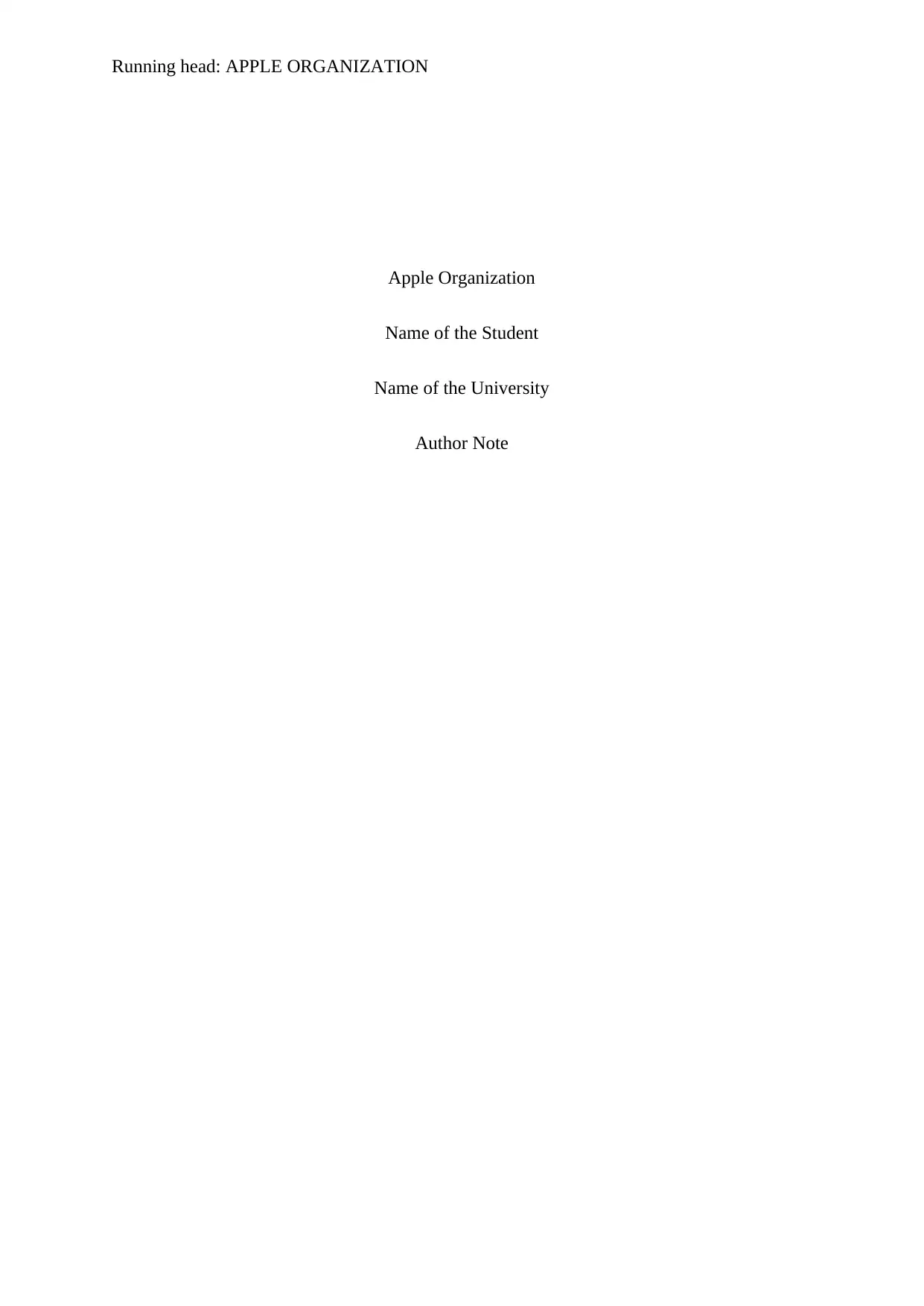
Running head: APPLE ORGANIZATION
Apple Organization
Name of the Student
Name of the University
Author Note
Apple Organization
Name of the Student
Name of the University
Author Note
Paraphrase This Document
Need a fresh take? Get an instant paraphrase of this document with our AI Paraphraser
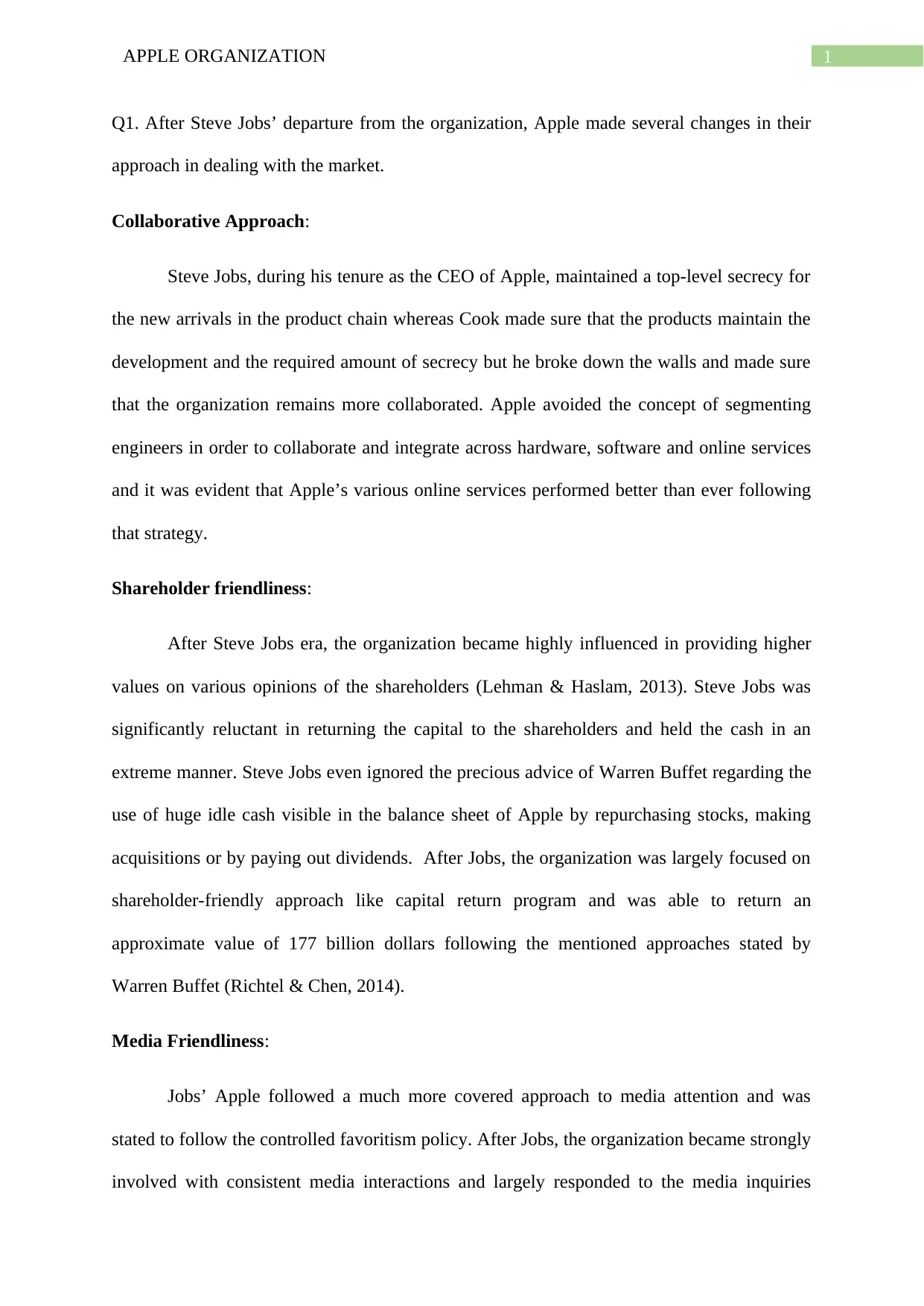
1APPLE ORGANIZATION
Q1. After Steve Jobs’ departure from the organization, Apple made several changes in their
approach in dealing with the market.
Collaborative Approach:
Steve Jobs, during his tenure as the CEO of Apple, maintained a top-level secrecy for
the new arrivals in the product chain whereas Cook made sure that the products maintain the
development and the required amount of secrecy but he broke down the walls and made sure
that the organization remains more collaborated. Apple avoided the concept of segmenting
engineers in order to collaborate and integrate across hardware, software and online services
and it was evident that Apple’s various online services performed better than ever following
that strategy.
Shareholder friendliness:
After Steve Jobs era, the organization became highly influenced in providing higher
values on various opinions of the shareholders (Lehman & Haslam, 2013). Steve Jobs was
significantly reluctant in returning the capital to the shareholders and held the cash in an
extreme manner. Steve Jobs even ignored the precious advice of Warren Buffet regarding the
use of huge idle cash visible in the balance sheet of Apple by repurchasing stocks, making
acquisitions or by paying out dividends. After Jobs, the organization was largely focused on
shareholder-friendly approach like capital return program and was able to return an
approximate value of 177 billion dollars following the mentioned approaches stated by
Warren Buffet (Richtel & Chen, 2014).
Media Friendliness:
Jobs’ Apple followed a much more covered approach to media attention and was
stated to follow the controlled favoritism policy. After Jobs, the organization became strongly
involved with consistent media interactions and largely responded to the media inquiries
Q1. After Steve Jobs’ departure from the organization, Apple made several changes in their
approach in dealing with the market.
Collaborative Approach:
Steve Jobs, during his tenure as the CEO of Apple, maintained a top-level secrecy for
the new arrivals in the product chain whereas Cook made sure that the products maintain the
development and the required amount of secrecy but he broke down the walls and made sure
that the organization remains more collaborated. Apple avoided the concept of segmenting
engineers in order to collaborate and integrate across hardware, software and online services
and it was evident that Apple’s various online services performed better than ever following
that strategy.
Shareholder friendliness:
After Steve Jobs era, the organization became highly influenced in providing higher
values on various opinions of the shareholders (Lehman & Haslam, 2013). Steve Jobs was
significantly reluctant in returning the capital to the shareholders and held the cash in an
extreme manner. Steve Jobs even ignored the precious advice of Warren Buffet regarding the
use of huge idle cash visible in the balance sheet of Apple by repurchasing stocks, making
acquisitions or by paying out dividends. After Jobs, the organization was largely focused on
shareholder-friendly approach like capital return program and was able to return an
approximate value of 177 billion dollars following the mentioned approaches stated by
Warren Buffet (Richtel & Chen, 2014).
Media Friendliness:
Jobs’ Apple followed a much more covered approach to media attention and was
stated to follow the controlled favoritism policy. After Jobs, the organization became strongly
involved with consistent media interactions and largely responded to the media inquiries
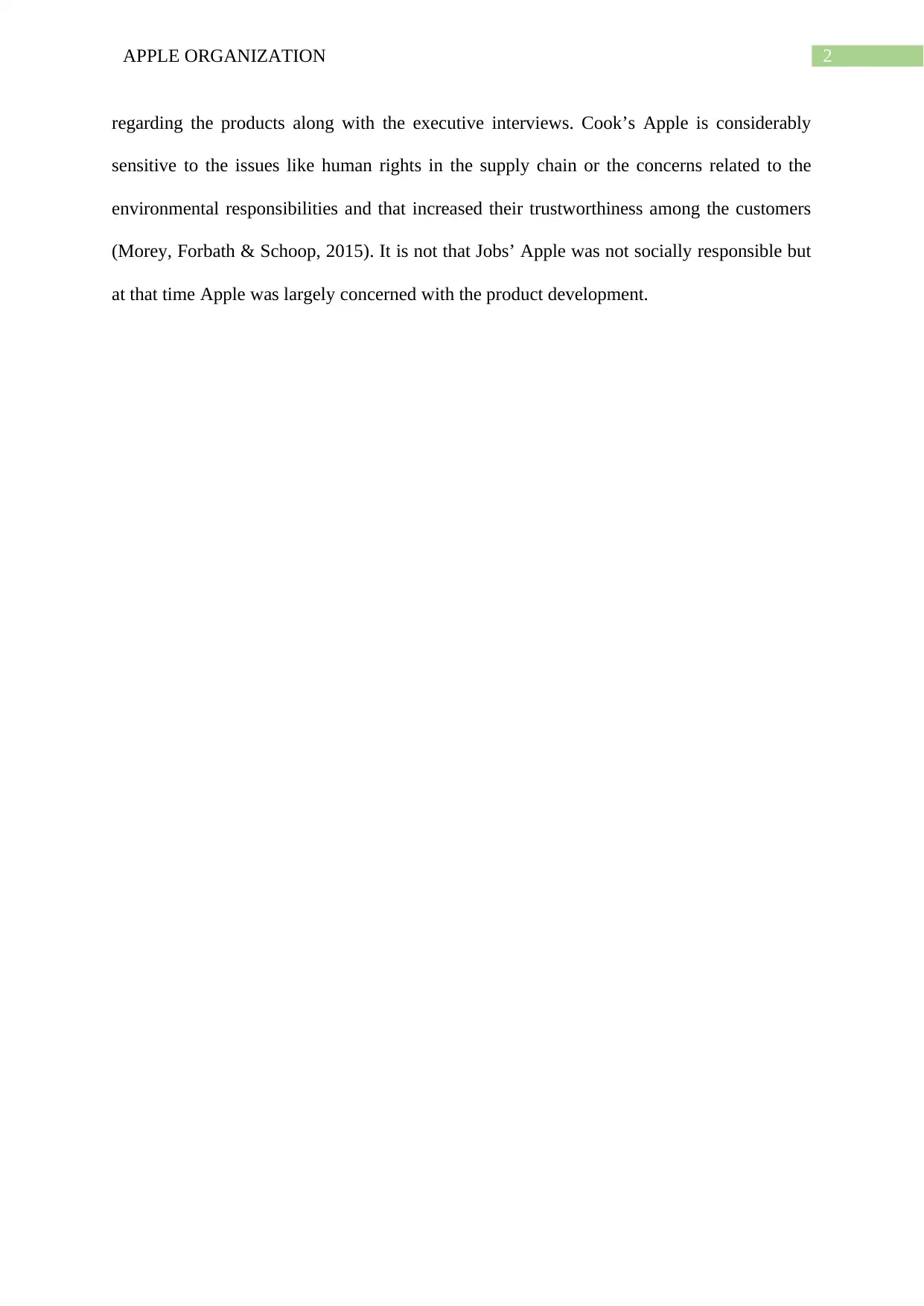
2APPLE ORGANIZATION
regarding the products along with the executive interviews. Cook’s Apple is considerably
sensitive to the issues like human rights in the supply chain or the concerns related to the
environmental responsibilities and that increased their trustworthiness among the customers
(Morey, Forbath & Schoop, 2015). It is not that Jobs’ Apple was not socially responsible but
at that time Apple was largely concerned with the product development.
regarding the products along with the executive interviews. Cook’s Apple is considerably
sensitive to the issues like human rights in the supply chain or the concerns related to the
environmental responsibilities and that increased their trustworthiness among the customers
(Morey, Forbath & Schoop, 2015). It is not that Jobs’ Apple was not socially responsible but
at that time Apple was largely concerned with the product development.
⊘ This is a preview!⊘
Do you want full access?
Subscribe today to unlock all pages.

Trusted by 1+ million students worldwide
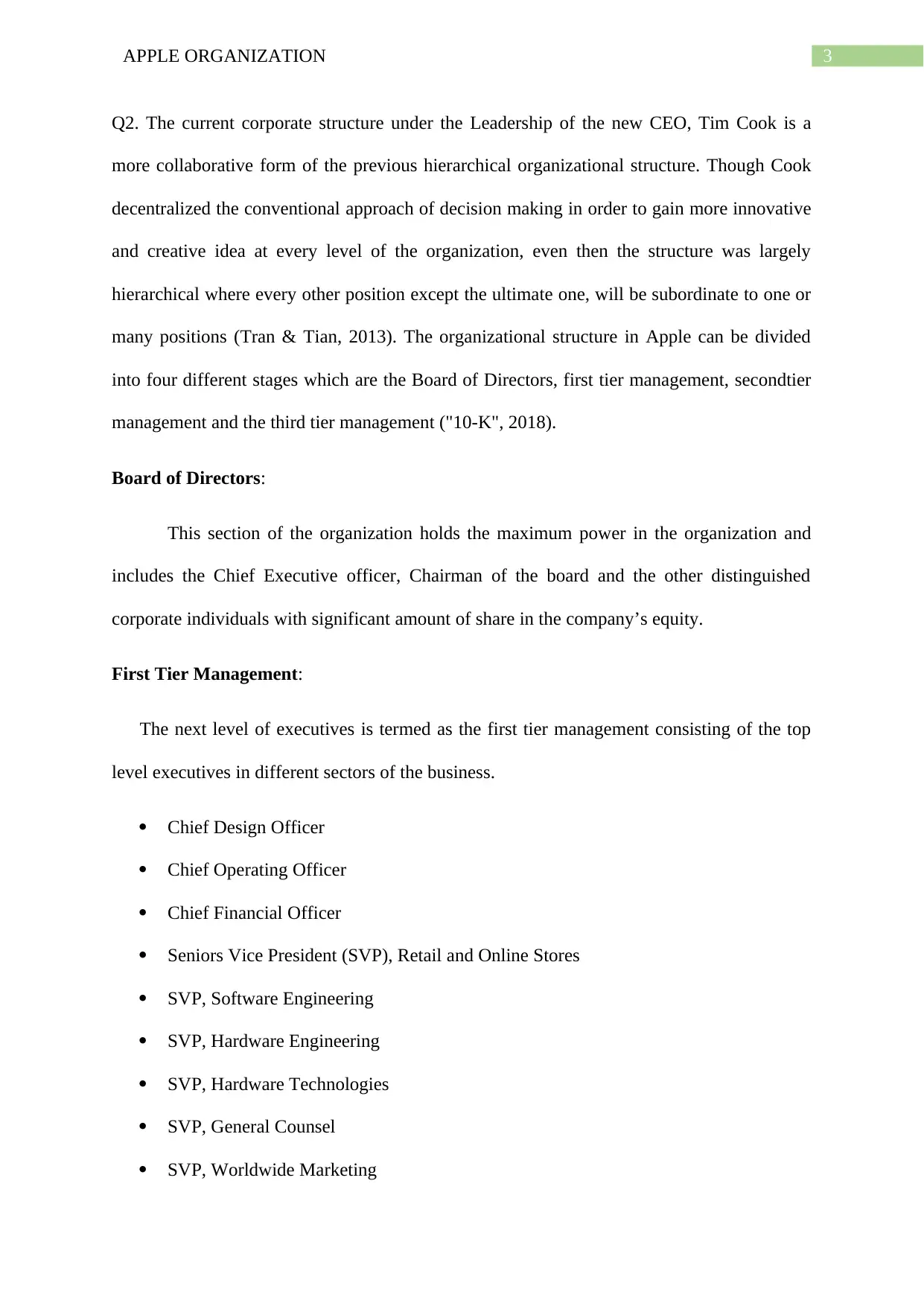
3APPLE ORGANIZATION
Q2. The current corporate structure under the Leadership of the new CEO, Tim Cook is a
more collaborative form of the previous hierarchical organizational structure. Though Cook
decentralized the conventional approach of decision making in order to gain more innovative
and creative idea at every level of the organization, even then the structure was largely
hierarchical where every other position except the ultimate one, will be subordinate to one or
many positions (Tran & Tian, 2013). The organizational structure in Apple can be divided
into four different stages which are the Board of Directors, first tier management, secondtier
management and the third tier management ("10-K", 2018).
Board of Directors:
This section of the organization holds the maximum power in the organization and
includes the Chief Executive officer, Chairman of the board and the other distinguished
corporate individuals with significant amount of share in the company’s equity.
First Tier Management:
The next level of executives is termed as the first tier management consisting of the top
level executives in different sectors of the business.
Chief Design Officer
Chief Operating Officer
Chief Financial Officer
Seniors Vice President (SVP), Retail and Online Stores
SVP, Software Engineering
SVP, Hardware Engineering
SVP, Hardware Technologies
SVP, General Counsel
SVP, Worldwide Marketing
Q2. The current corporate structure under the Leadership of the new CEO, Tim Cook is a
more collaborative form of the previous hierarchical organizational structure. Though Cook
decentralized the conventional approach of decision making in order to gain more innovative
and creative idea at every level of the organization, even then the structure was largely
hierarchical where every other position except the ultimate one, will be subordinate to one or
many positions (Tran & Tian, 2013). The organizational structure in Apple can be divided
into four different stages which are the Board of Directors, first tier management, secondtier
management and the third tier management ("10-K", 2018).
Board of Directors:
This section of the organization holds the maximum power in the organization and
includes the Chief Executive officer, Chairman of the board and the other distinguished
corporate individuals with significant amount of share in the company’s equity.
First Tier Management:
The next level of executives is termed as the first tier management consisting of the top
level executives in different sectors of the business.
Chief Design Officer
Chief Operating Officer
Chief Financial Officer
Seniors Vice President (SVP), Retail and Online Stores
SVP, Software Engineering
SVP, Hardware Engineering
SVP, Hardware Technologies
SVP, General Counsel
SVP, Worldwide Marketing
Paraphrase This Document
Need a fresh take? Get an instant paraphrase of this document with our AI Paraphraser
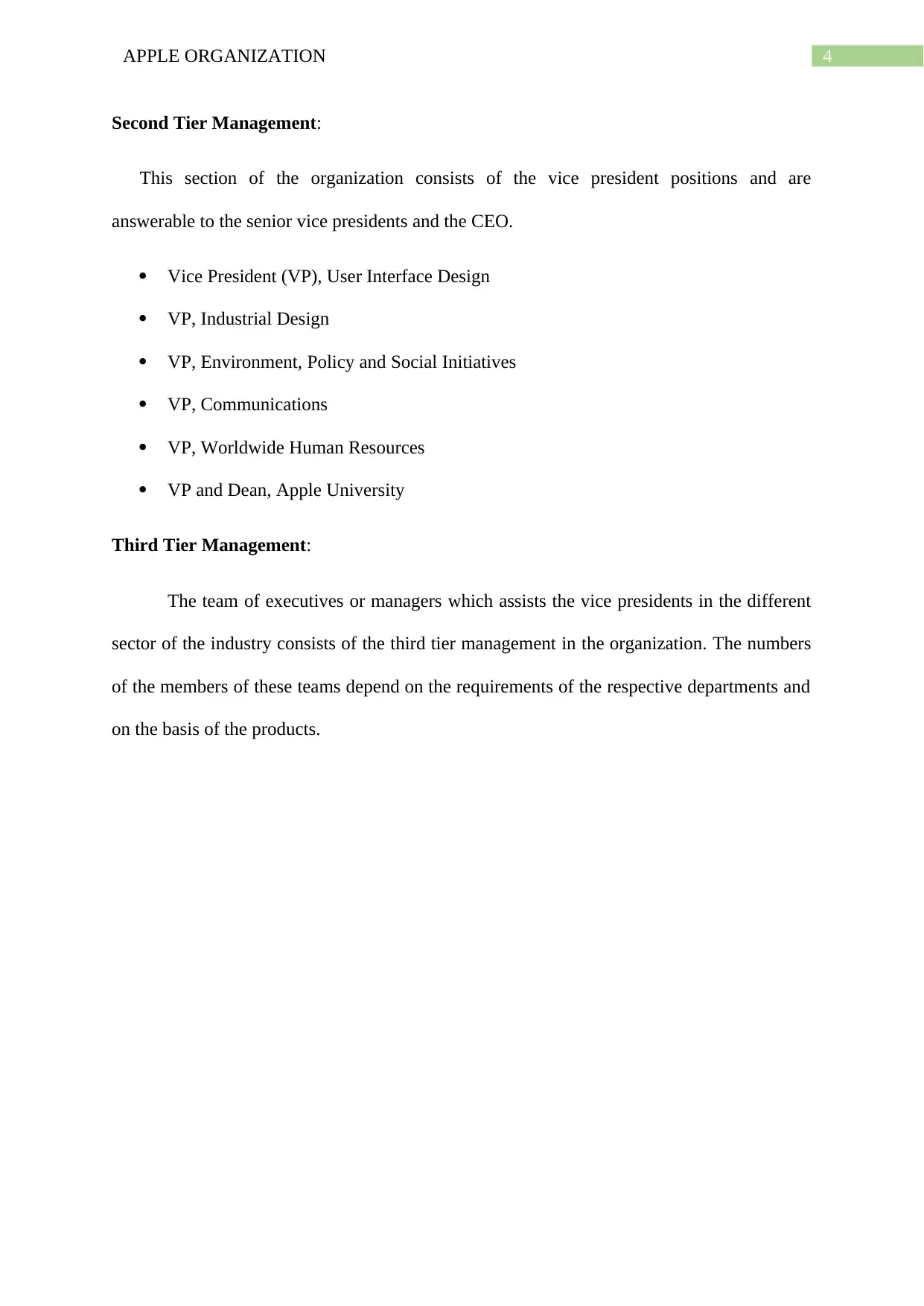
4APPLE ORGANIZATION
Second Tier Management:
This section of the organization consists of the vice president positions and are
answerable to the senior vice presidents and the CEO.
Vice President (VP), User Interface Design
VP, Industrial Design
VP, Environment, Policy and Social Initiatives
VP, Communications
VP, Worldwide Human Resources
VP and Dean, Apple University
Third Tier Management:
The team of executives or managers which assists the vice presidents in the different
sector of the industry consists of the third tier management in the organization. The numbers
of the members of these teams depend on the requirements of the respective departments and
on the basis of the products.
Second Tier Management:
This section of the organization consists of the vice president positions and are
answerable to the senior vice presidents and the CEO.
Vice President (VP), User Interface Design
VP, Industrial Design
VP, Environment, Policy and Social Initiatives
VP, Communications
VP, Worldwide Human Resources
VP and Dean, Apple University
Third Tier Management:
The team of executives or managers which assists the vice presidents in the different
sector of the industry consists of the third tier management in the organization. The numbers
of the members of these teams depend on the requirements of the respective departments and
on the basis of the products.
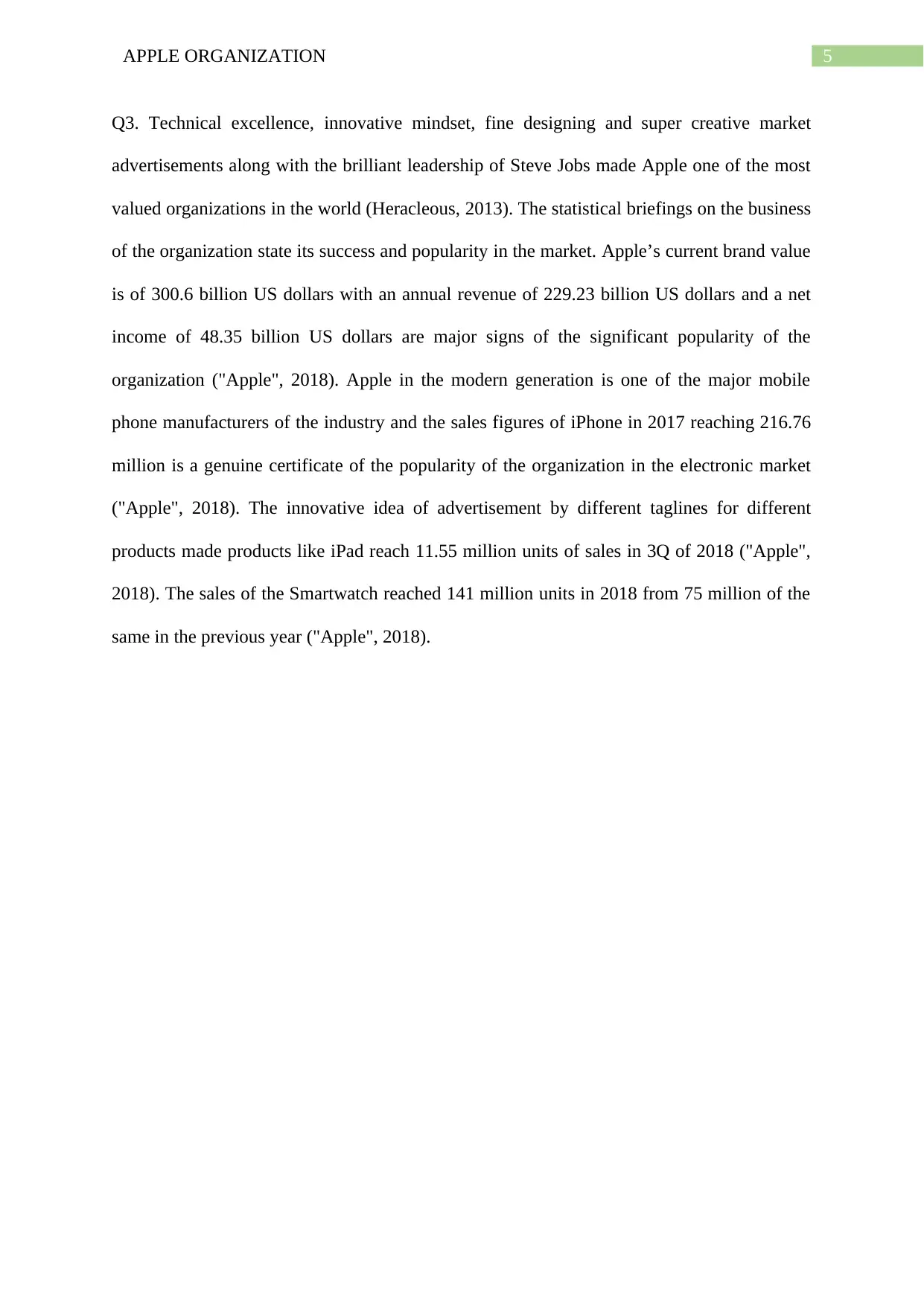
5APPLE ORGANIZATION
Q3. Technical excellence, innovative mindset, fine designing and super creative market
advertisements along with the brilliant leadership of Steve Jobs made Apple one of the most
valued organizations in the world (Heracleous, 2013). The statistical briefings on the business
of the organization state its success and popularity in the market. Apple’s current brand value
is of 300.6 billion US dollars with an annual revenue of 229.23 billion US dollars and a net
income of 48.35 billion US dollars are major signs of the significant popularity of the
organization ("Apple", 2018). Apple in the modern generation is one of the major mobile
phone manufacturers of the industry and the sales figures of iPhone in 2017 reaching 216.76
million is a genuine certificate of the popularity of the organization in the electronic market
("Apple", 2018). The innovative idea of advertisement by different taglines for different
products made products like iPad reach 11.55 million units of sales in 3Q of 2018 ("Apple",
2018). The sales of the Smartwatch reached 141 million units in 2018 from 75 million of the
same in the previous year ("Apple", 2018).
Q3. Technical excellence, innovative mindset, fine designing and super creative market
advertisements along with the brilliant leadership of Steve Jobs made Apple one of the most
valued organizations in the world (Heracleous, 2013). The statistical briefings on the business
of the organization state its success and popularity in the market. Apple’s current brand value
is of 300.6 billion US dollars with an annual revenue of 229.23 billion US dollars and a net
income of 48.35 billion US dollars are major signs of the significant popularity of the
organization ("Apple", 2018). Apple in the modern generation is one of the major mobile
phone manufacturers of the industry and the sales figures of iPhone in 2017 reaching 216.76
million is a genuine certificate of the popularity of the organization in the electronic market
("Apple", 2018). The innovative idea of advertisement by different taglines for different
products made products like iPad reach 11.55 million units of sales in 3Q of 2018 ("Apple",
2018). The sales of the Smartwatch reached 141 million units in 2018 from 75 million of the
same in the previous year ("Apple", 2018).
⊘ This is a preview!⊘
Do you want full access?
Subscribe today to unlock all pages.

Trusted by 1+ million students worldwide
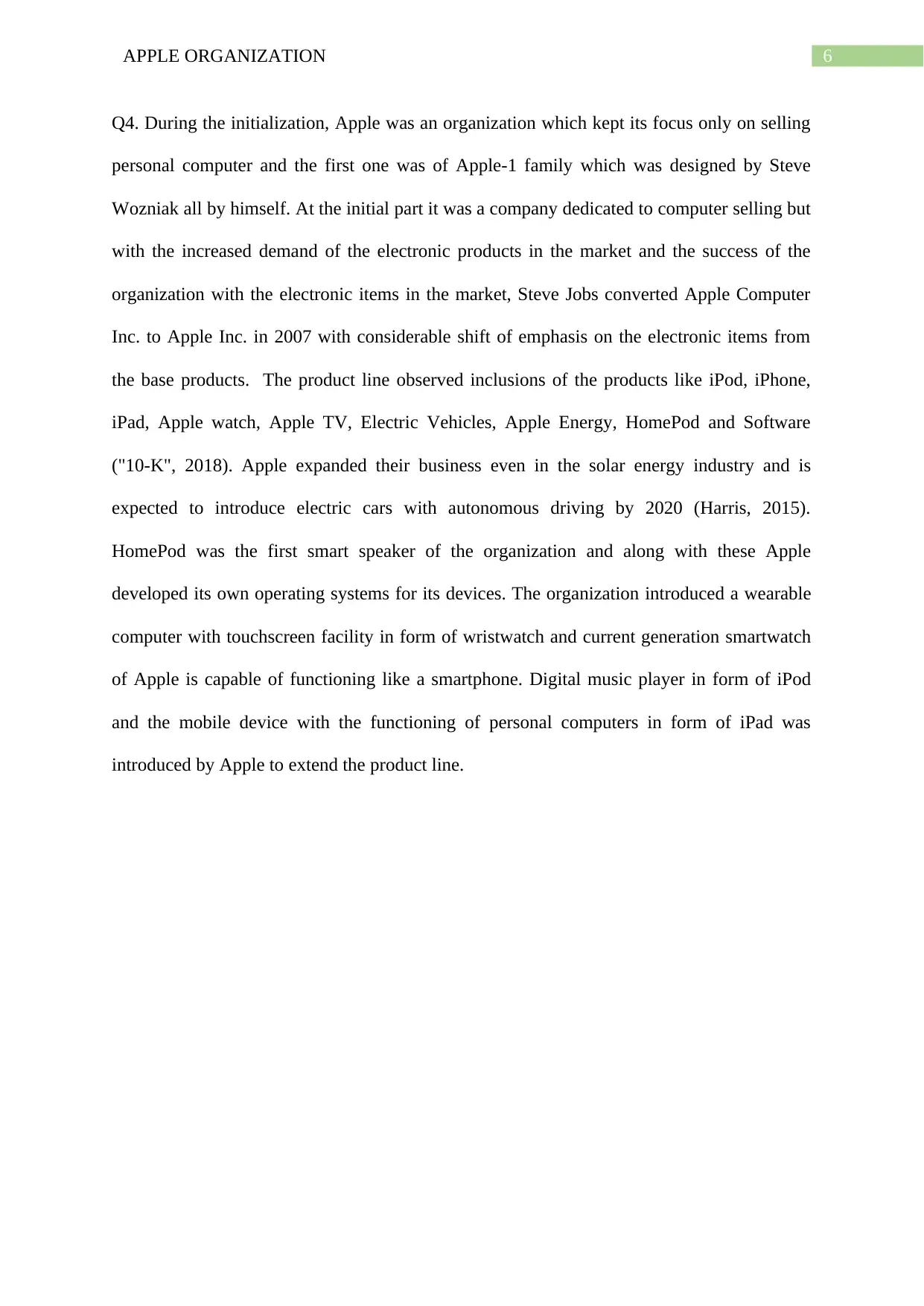
6APPLE ORGANIZATION
Q4. During the initialization, Apple was an organization which kept its focus only on selling
personal computer and the first one was of Apple-1 family which was designed by Steve
Wozniak all by himself. At the initial part it was a company dedicated to computer selling but
with the increased demand of the electronic products in the market and the success of the
organization with the electronic items in the market, Steve Jobs converted Apple Computer
Inc. to Apple Inc. in 2007 with considerable shift of emphasis on the electronic items from
the base products. The product line observed inclusions of the products like iPod, iPhone,
iPad, Apple watch, Apple TV, Electric Vehicles, Apple Energy, HomePod and Software
("10-K", 2018). Apple expanded their business even in the solar energy industry and is
expected to introduce electric cars with autonomous driving by 2020 (Harris, 2015).
HomePod was the first smart speaker of the organization and along with these Apple
developed its own operating systems for its devices. The organization introduced a wearable
computer with touchscreen facility in form of wristwatch and current generation smartwatch
of Apple is capable of functioning like a smartphone. Digital music player in form of iPod
and the mobile device with the functioning of personal computers in form of iPad was
introduced by Apple to extend the product line.
Q4. During the initialization, Apple was an organization which kept its focus only on selling
personal computer and the first one was of Apple-1 family which was designed by Steve
Wozniak all by himself. At the initial part it was a company dedicated to computer selling but
with the increased demand of the electronic products in the market and the success of the
organization with the electronic items in the market, Steve Jobs converted Apple Computer
Inc. to Apple Inc. in 2007 with considerable shift of emphasis on the electronic items from
the base products. The product line observed inclusions of the products like iPod, iPhone,
iPad, Apple watch, Apple TV, Electric Vehicles, Apple Energy, HomePod and Software
("10-K", 2018). Apple expanded their business even in the solar energy industry and is
expected to introduce electric cars with autonomous driving by 2020 (Harris, 2015).
HomePod was the first smart speaker of the organization and along with these Apple
developed its own operating systems for its devices. The organization introduced a wearable
computer with touchscreen facility in form of wristwatch and current generation smartwatch
of Apple is capable of functioning like a smartphone. Digital music player in form of iPod
and the mobile device with the functioning of personal computers in form of iPad was
introduced by Apple to extend the product line.
Paraphrase This Document
Need a fresh take? Get an instant paraphrase of this document with our AI Paraphraser
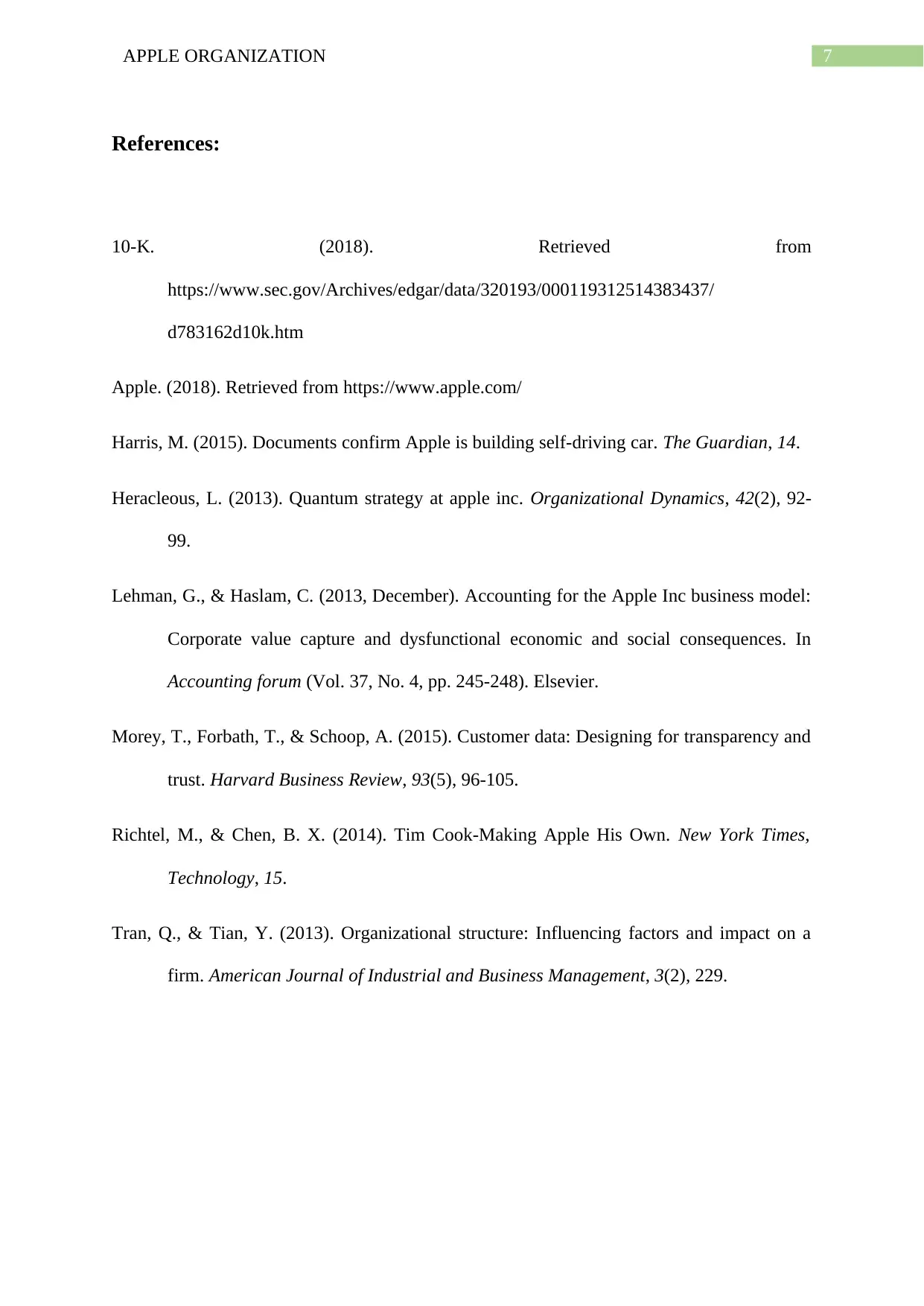
7APPLE ORGANIZATION
References:
10-K. (2018). Retrieved from
https://www.sec.gov/Archives/edgar/data/320193/000119312514383437/
d783162d10k.htm
Apple. (2018). Retrieved from https://www.apple.com/
Harris, M. (2015). Documents confirm Apple is building self-driving car. The Guardian, 14.
Heracleous, L. (2013). Quantum strategy at apple inc. Organizational Dynamics, 42(2), 92-
99.
Lehman, G., & Haslam, C. (2013, December). Accounting for the Apple Inc business model:
Corporate value capture and dysfunctional economic and social consequences. In
Accounting forum (Vol. 37, No. 4, pp. 245-248). Elsevier.
Morey, T., Forbath, T., & Schoop, A. (2015). Customer data: Designing for transparency and
trust. Harvard Business Review, 93(5), 96-105.
Richtel, M., & Chen, B. X. (2014). Tim Cook-Making Apple His Own. New York Times,
Technology, 15.
Tran, Q., & Tian, Y. (2013). Organizational structure: Influencing factors and impact on a
firm. American Journal of Industrial and Business Management, 3(2), 229.
References:
10-K. (2018). Retrieved from
https://www.sec.gov/Archives/edgar/data/320193/000119312514383437/
d783162d10k.htm
Apple. (2018). Retrieved from https://www.apple.com/
Harris, M. (2015). Documents confirm Apple is building self-driving car. The Guardian, 14.
Heracleous, L. (2013). Quantum strategy at apple inc. Organizational Dynamics, 42(2), 92-
99.
Lehman, G., & Haslam, C. (2013, December). Accounting for the Apple Inc business model:
Corporate value capture and dysfunctional economic and social consequences. In
Accounting forum (Vol. 37, No. 4, pp. 245-248). Elsevier.
Morey, T., Forbath, T., & Schoop, A. (2015). Customer data: Designing for transparency and
trust. Harvard Business Review, 93(5), 96-105.
Richtel, M., & Chen, B. X. (2014). Tim Cook-Making Apple His Own. New York Times,
Technology, 15.
Tran, Q., & Tian, Y. (2013). Organizational structure: Influencing factors and impact on a
firm. American Journal of Industrial and Business Management, 3(2), 229.
1 out of 8
Your All-in-One AI-Powered Toolkit for Academic Success.
+13062052269
info@desklib.com
Available 24*7 on WhatsApp / Email
![[object Object]](/_next/static/media/star-bottom.7253800d.svg)
Unlock your academic potential
Copyright © 2020–2025 A2Z Services. All Rights Reserved. Developed and managed by ZUCOL.
